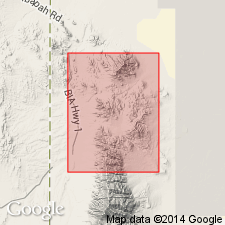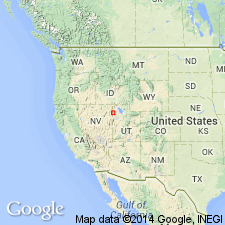
- Usage in publication:
-
- Young Peak dolomite*
- Modifications:
-
- Original reference
- Dominant lithology:
-
- Dolomite
- AAPG geologic province:
-
- Great Basin province
Summary:
Pg. 421-432. Young Peak dolomite. Massive dark-gray to black crystalline dolomite spangled with short white rods of dolomite. To north the dolomite interfingers with shaly limestones similar to those in underlying Abercrombie formation. Less than 5 miles to north only a few feet of dolomite can be found, and the stratigraphic interval of the formation is occupied by portions of Abercrombie formation. Top bed is a dark-gray dolomite containing abundant nodules of dark-gray chert which may reach several feet in diameter. It is overlain by a cream-colored, finely laminated dolomite which forms basal bed of Trippe limestone. Thickness 600 feet. No fossils, but unquestionably is Middle Cambrian.
Well exposed on Young Peak, on south side of Dry Canyon, Gold Hill district, [Gold Hill quadrangle, Tooele Co.], western UT.
[See also USGS Prof. Paper 177, 1934.]
Source: US geologic names lexicon (USGS Bull. 896, p. 2391).

- Usage in publication:
-
- Young Peak Dolomite
- Modifications:
-
- [Not used]
- AAPG geologic province:
-
- Great Basin province
Summary:
Pg. 8 (fig. 5, Deep Creek Mountains, Utah, column). Majority of information below gleaned from L.B. McCollum and M.B. McCollum, 1984, IN Kerns, G.J., and Kerns, R.L., Jr., eds., Geology of northwest Utah, southern Idaho, and northeast Nevada, Field Conf. Gdbk., Utah Geol. Assoc. Pub., no. 13, p. 37 (fig. 2), 38-39.
[In Deep Creek Mountains, Utah, authors replace Nolan's Middle Cambrian Abercrombie Formation and Young Peak Dolomite with House Range terminology of Hintze and Robison (1975). Rocks previously assigned to the Young Peak are reallocated to the Pierson Cove Formation. (Rocks previously assigned to the Abercrombie are reallocated to, ascending: Howell Formation, Chisholm Shale, Dome Limestone, Whirlwind Formation, Swasey Limestone, Wheeler Shale, and Pierson Cove Formation.) Use of Middle Cambrian Abercrombie Formation and Young Peak Dolomite in the Deep Creek Mountains, Utah, retained by the USGS and the Utah Geological Survey.]
Source: Publication.
For more information, please contact Nancy Stamm, Geologic Names Committee Secretary.
Asterisk (*) indicates published by U.S. Geological Survey authors.
"No current usage" (†) implies that a name has been abandoned or has fallen into disuse. Former usage and, if known, replacement name given in parentheses ( ).
Slash (/) indicates name conflicts with nomenclatural guidelines (CSN, 1933; ACSN, 1961, 1970; NACSN, 1983, 2005, 2021). May be explained within brackets ([ ]).

